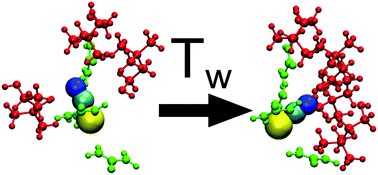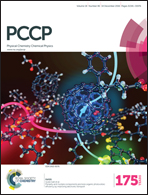Solvation dynamics of an ionic probe in choline chloride-based deep eutectic solvents†
Abstract
Solvation of the thiocyanate ion in three different deep eutectic solvents (DES) was investigated by linear FTIR spectroscopy, and Two Dimensional IR spectroscopy. Linear infrared spectroscopy reveals that the thiocyanate ion forms a hydrogen bond through its sulphur atom, while its nitrile end remains free. Photon-echo vibrational spectroscopy shows that the thiocyanate has a frequency–frequency correlation function (FFCF) with two distinct dynamics occurring on the picosecond time scale in all of the studied solvents. The observed dynamics is assigned to in-place and diffusional motions of the components within the thiocyanate solvation shell. Molecular dynamics simulations and ab initio calculations confirm the experimental findings and their molecular interpretation. In addition, theoretical modeling of the thiocyanate nitrile stretch lineshape suggests that alcohol-based DES are more structurally disorganized than the amide-based analogue. However, the organization observed in the different DES is not sufficient to explain physical properties, such as density, indicating that the amount of defects (i.e., hole theory) is not sufficient to fully describe the properties of DES.



 Please wait while we load your content...
Please wait while we load your content...